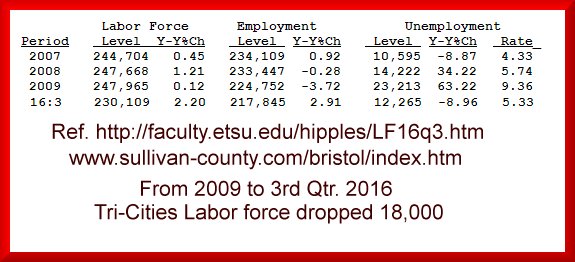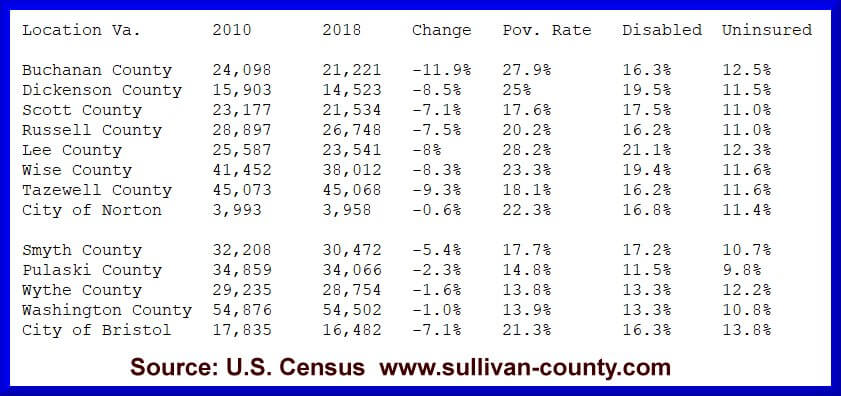Smith County Virginia Looses 300 Jobs at Merillat
by Lewis Loflin
Update May 2016: some workers rehired with another company. See Gov. McAuliffe Phony New Jobs in Smyth County Virginia.
Smith County Virginia like neighboring Washington County and Bristol has seen thousands of manufacturing jobs disappear over the last 20 years. In 2012 the sad tradition continues as Merillat canned 261 hourly employees and 19 salaried workers at its two plants in Atkins in Smyth County, Virginia.
"The two plants in Atkins manufacture cabinet doors and panels. The first plant, producing cabinet doors, opened in 1977, and there are 201 hourly and 16 salaried employees affected by this plant closing. The second plant, producing panels, opened in 1991, and there are 60 hourly and three salaried employees affected by the planned closing."
The reasons given are downturn in the economy, but the real reason it seems is automation and job shifting. They also canned 190 workers in New Jersey and will shift work to Mt. Jackson, Virginia and Sayre, Pennsylvania.
Congressman Morgan Griffith says in a news release November, 16, 2012,
"I am deeply troubled by today's announcement that Merillat will be closing its 2 manufacturing plants in Atkins. These job losses negatively impact the entire community, but most significantly the hard-working employees and their families. There is no news that can replace my sadness for the families who are facing the layoffs at Merillat shortly after Christmas. However, I would be remiss if I did not applaud Governor McDonnell's efforts to bring jobs to the Commonwealth. In the shadow of this bad news from Smyth County, there is some good news in another part of the Ninth District.
Governor McDonnell today announced an expansion of HanesBrands adding 50 new jobs in Patrick County. I am glad that we have had one step forward, but I am still troubled that it seems that for every step forward, there are four steps back. I will continue to promote job-creating policies and fight against over regulation to get our economy back on track."
First Mr Griffith this was not due to "over regulation", but to automation and chasing corporate welfare. Corporate welfare from states such as Virginia cost all state/local taxpayers a staggering $80 billion a year as job poor communities cut each others throats to lure in businesses such as Merillat to Mt. Jackson.
The claim of so-called 50 new jobs from HanesBrands is in fact false, they just fired 60 workers at Mt Airy N.C. at the same time of this "investment". I'm sure these relocated jobs underwritten by tax dollars was being celebrated in Patrick County, Virginia. In fact HanesBrands has canned over 2000 workers since 2008 including 440 in Winston-Salem.
The over $80 billion for corporate welfare from state/local governments is double what government spends on housing assistance for poor people Republicans want to cut. Texas is the biggest corporate welfare state spending around $19 billion a year, while at the same time cutting $5 billion from education. We've all heard about Republican Gov. Rick Perry and his so-called "job creation" miracle. But the facts on the ground are not as they seem. Of those whopping 279,000 jobs from 2007-2011, a study by the non-partisan Center for Immigration Studies found that:
...81 percent of those "new jobs" in Texas went to immigrants at least half illegal. It's part of a three-decade long pattern of displacing the native born workforce with cheaper imported and often illegal labor. Of those jobs taken by newly arrived immigrants, 93 percent were non-citizens...most arrived after 2007..."
Many of the jobs are not new jobs, but jobs simply relocating around the country to cut wages for their workers and chasing expensive "incentives". The loss of 18,000 union jobs by Hostess recently will certainly be shipped to labor hostile low-wage states such as Virginia and Texas and be underwritten by generous corporate welfare packages. Many of the jobs may not even go to U.S. citizens. Where are you on this one Mr. Griffith?
Ref Lines Blur as Texas Gives Industries a Bonanza New York Times Dec. 2, 2012.
HanesBrands laying off 60 in Mount Airy
Nov 29, 2012 Ref. http://www.wxii12.com
MOUNT AIRY, N.C. - HanesBrands is cutting 60 positions at its sock knitting plant in Mount Airy...However, some of the laid-off employees could find work at HanesBrands' expansion in Patrick County, VA. About 50 jobs will be added to the Woolwine facility, and interviews for those jobs will begin in December. Laid-off employees will be put at the top of the list for the new Woolwine jobs, Hall said. About 20 workers at the Mount Airy plant already live in Patrick County, Hall said. (This is another example of simply shifting jobs around.)
(Why am I not surprised?)
Hanesbrands: No severance for laid-off workers by Keith Strange Staff Reporter
A spokesman for Hanesbrands, Inc. said some information released to The Mount Airy News about the severance package for laid-off employees was incorrect. "I gave you some bad information on severance for the layoffs at our Mount Airy socks plant," said spokesman Matt Hall. A previous story on the layoffs, published in Saturday's edition of The News, reported that the affected workers would be compensated with a lump-sum payment based on longevity."Our severance policy calls for severance in cases of full plant closures," Hall said. "In case of partial layoffs, employees are eligible to be reinstated when openings occur, such as when there are retirements, turnover or other things that result in openings. So the employees in this case will be placed on callback lists to fill openings as they arise in Mount Airy, and they will be put on the list to fill openings for new jobs being created in Woolwine, Va."
Posted Dec. 9, 2012.
- Deism
- Gnosticism
- Original Sin
- Trinity
- End Times
- Pelagius
- Martin Luther
- Jesus
- Unitarianism
- Christianity
- Judaism
- Paganism
- New Age
See Three Decades of Job Losses in Southwest Virginia
Note that minimum wage in 1970 was $1.60 adjusted for inflation is $10.46 in 2018. That is what I call adjusted minimum wage. Assuming one even gets 40 per week that's for 52 weeks that equals $21,756. Per capita income in Bristol Virginia 2018 is $21,589. It is similar to this across the whole region.
Third world? Some have called us the China of America minus jobs.
Just a few of hundreds of plant closings see Smyth County the China of America loses jobs.

Update September 3, 2019. Based on data from Dr. Steb Hipple economist at East Tennessee State University (retired), his data goes to the 3rd. quarter of 2016. The level of job losses is Tri-Cities is staggering, worse than what even I thought.
(The Tri-Cities Consolidated Statistical Area is composed of the Kingsport/Bristol MSA and the Johnson City MSA.).
The Bristol TN-VA, Kingsport, and Johnson City Urbanized Area Labor Market lost thousands of jobs shrinking the labor force that shrank the unemployment rates. The above table shows a decline of labor force by almost 18,000. But it gets worse.
Includes: Johnson City, TN, Carter County, Unicoi County, Washington County.
All workers BLS:
2016 78,140 workers, Median hourly wage $14.47, Annual $40,140
2018 77,020 workers, Median hourly wage $15.38, Annual $42,740
Labor force fell 1120 jobs in 2 years.
Kingsport-Bristol-Bristol, TN-VA MSA includes: Bristol city, VA, Hawkins County, TN, Scott County, VA, Sullivan County, TN, Washington County, VA.
All workers BLS:
2016: 118,470, Median hourly wage $15.27, Annual $41,050
2018: 116,150, Median hourly wage $16.50, Annual $43,480
Labor force fell 2,320 in in 2 years.
That's not the worst of it still. For Tri-Cities the total labor force is 193,170. The labor force shrank by 3,440 jobs in 2 years - during a so-called boom. In 2009 the labor force was 247,965, minus 193,170 equals a staggering loss of 54,795 less people are working in 2019 than in 2009!.
I can't believe this myself. Anyone working here knows it is bad. That could be explained by high poverty and disability rates, and large numbers of retirees leaving the labor force. I don't know because a lot of data is hidden from the public. But makes sense when we look at the national labor force declines.
